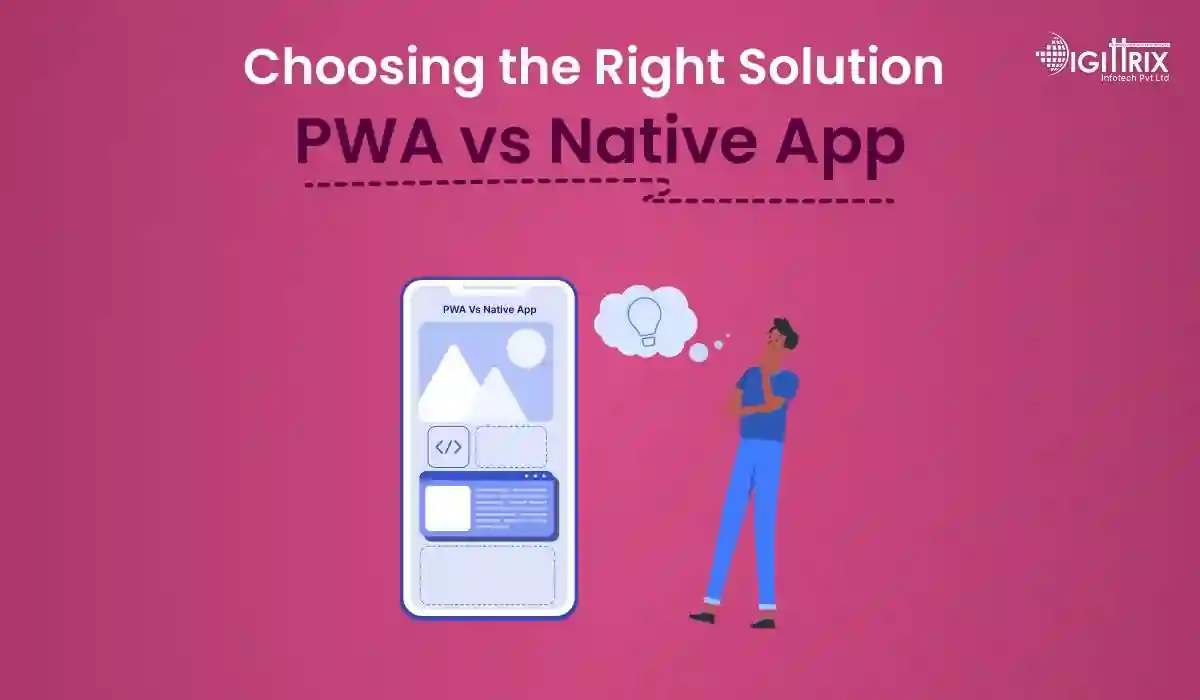PWA and Native Apps offer different benefits. PWAs are cost-effective and SEO-friendly, while Native Apps provide high performance, security and full device functionality.
Highlights
With Over 14 years of Experience in the IT Field, Helping Companies Optimise there Products for more Conversions

Mobile applications have become a key part of businesses in various industries. Companies planning to develop an app often face a crucial decision—whether to go for a Progressive Web App (PWA) or a Native App. Both have their strengths and limitations, making it important to analyze them before making a choice.
In this article, we will break down the key differences between PWA and Native Apps, their advantages and disadvantages, and which option would be more suitable in 2025.
Website or web app? Check Digittrix's guide to understand the key differences!
A Progressive Web App (PWA) is a web-based application that behaves like a mobile app. It is built using web technologies like HTML, CSS, and JavaScript, but can be accessed through a web browser rather than being downloaded from an app store.
According to a Smashing Magazine report, PWAs improve mobile conversion rates by 36% and reduce bounce rates significantly.
Key Features of PWA:
A Native App is a mobile application developed specifically for an operating system like Android or iOS. These apps are built using Swift or Objective-C for iOS and Java or Kotlin for Android. Unlike PWAs, native apps are downloaded from the Google Play Store or Apple App Store.
According to Apps Flyer, Native apps engage users 3x more than PWAs.
Key Features of Native Apps:
A Progressive Web App is suitable for:
Some well-known companies using PWAs include Twitter Lite, Pinterest, and Flipkart.
Google for Developers report shows, PWAs reduce page load time by 50% and improve user experience and speed.
Why do businesses prefer React Native? Check Digittrix's insights on its benefits for all business sizes!
A Native App is the right choice if:
Some famous native apps include WhatsApp, Instagram, and Uber.
The choice between PWA and Native App depends on the business model, target audience, and app requirements.
As technology continues to grow, React Native app development has emerged as a popular approach for businesses that want the advantages of both. React Native development companies build apps that work on both iOS and Android, reducing costs while maintaining a near-native experience.
For businesses involved in progressive web app development, PWA remains a great choice for delivering web-based experiences without requiring users to install anything.
With the increasing demand for on-demand app development, companies are carefully considering their options. Both PWA and Native Apps have their place in 2025, and the final decision should be based on project goals, budget, and user needs.
Both PWA and Native Apps offer unique advantages, and the right choice depends on your business needs. If you want faster deployment and easy access for users, PWA is a practical option. However, if you require better performance, security, and deep integration with devices, then Native App development is the preferred route.
For those looking for a balance between both, hybrid approaches like React Native offer a middle ground. Whether you're planning an app for e-commerce, healthcare, or on-demand services, the right approach will ensure a smooth and efficient user experience.
Deciding between a Progressive Web App (PWA) and a Native App is crucial for businesses looking to build high-performing mobile applications. PWAs offer cost-effective, cross-platform accessibility with web-based functionality, while Native Apps provide superior performance, full device integration, and a seamless user experience. The right choice depends on your business goals, user needs, and technical requirements.
At Digittrix, we specialize in both PWA development and Native App development, delivering customized mobile solutions tailored to your business needs. With 14 years of experience and a team of skilled developers, we create high-quality applications that run smoothly across devices, ensuring optimal performance and engagement.
Need expert guidance on choosing between a PWA and a Native App? Schedule a consultation with our developers today! Call +91 8727000867 or email digittrix@gmail.com for all your queries.

Do you need help in Mobile App development?




Join over 1500+ businesses we've already helped!
PWAs run in web browsers and don’t require installation, while native apps are platform-specific and offer better performance and device integration.
Yes, PWAs have lower development costs since they use a single codebase for all platforms, whereas native apps require separate development for iOS and Android.
PWAs can work offline to some extent using service workers, but native apps have more robust offline capabilities.
Native apps generally offer better performance as they are optimized for specific operating systems, while PWAs rely on browser performance.

©2025Digittrix Infotech Private Limited , All rights reserved.